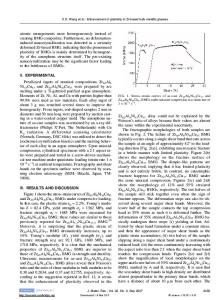Plasticity at Crack Tips in Zr-Based Bulk Metallic Glasses
- PDF / 2,456,213 Bytes
- 6 Pages / 612 x 792 pts (letter) Page_size
- 108 Downloads / 463 Views
Plasticity at Crack Tips in Zr-Based Bulk Metallic Glasses Jing Li1 , Xiaofeng Gu1 , Li-Qian Xing1 , Ken Livi2 and T. C. Hufnagel1 1 Department of Materials Science and Engineering, Johns Hopkins University, Baltimore, Maryland 21218, U.S.A. 2 Department of Earth and Planetary Sciences, Johns Hopkins University, Baltimore, Maryland 21218, U.S.A. ABSTRACT We have examined the structure of plastic deformation zones ahead of the tips of microcracks in Zr-based bulk metallic glass Zr57Ti5Cu20Ni8Al10. We have used an axially aligned dark field transmission electron microscopy technique, with the objective aperture placed to form images using electrons from several different areas of the diffraction patterns. We also compared Fourier transforms of the high resolution transmission electron microscopy images of deformed and undeformed regions to extract additional structural information. The plastic zones produce enhanced low-angle scattering of electrons and an apparent broadening of the amorphous halo, suggesting increased disorder and the presence of voids in the deformed zones. These results are consistent with an increased degree of atomic-scale disorder and enhanced free volume in highly deformed regions, which may provide a partial explanation of the manner in which plastic deformation occurs in metallic glasses. INTRODUCTION In bulk metallic glasses, plastic deformation is concentrated into highly localized narrow regions called shear bands. An understanding of the atomic scale structure of these regions may shed some light on the nature of plastic deformation in metallic glasses. The nature of the atomicscale structural changes in shear bands in metallic glasses is unknown, although disruption of chemical short-range order [1] and increased free volume [2,3] have been suggested. Experimental evidence for these models is limited. Recent positron annihilation results suggest the existence of increased free volume in deformed metallic glasses, but this technique does not have the spatial resolution necessary to investigate shear bands in detail [4]. Transmission electron microscopy (TEM) has sufficient spatial resolution to image individual shear bands. Donovan and Stobbs examined shear bands in rapidly quenched glasses [5], but little work has been done on bulk metallic glasses. In this study, we have investigated the structure of shear bands in the form of plastic zones ahead of microcracks caused by deformation of the TEM foils for Zr-base bulk metallic glass Zr57Ti5Cu20Ni8Al10. EXPERIMENTAL TECHNIQUES We examined samples of bulk metallic glass Zr57Ti5Cu20Ni8Al10 both in the as-cast and deformed state (those loaded past the yield point in uniaxial compression). TEM disks (diameter 3 mm) were cut from the bulk cylinders and mechanically polished to a thickness of 30-40 microns. TEM specimens were prepared in two ways: (1) Electropolishing to perforation with an electrolyte consisting of 70% ethanol and 30% perchloric acid at –30eC, followed by ion L12.19.1
thinning at a low angle (11e), with low voltage (3 kV) and
Data Loading...











